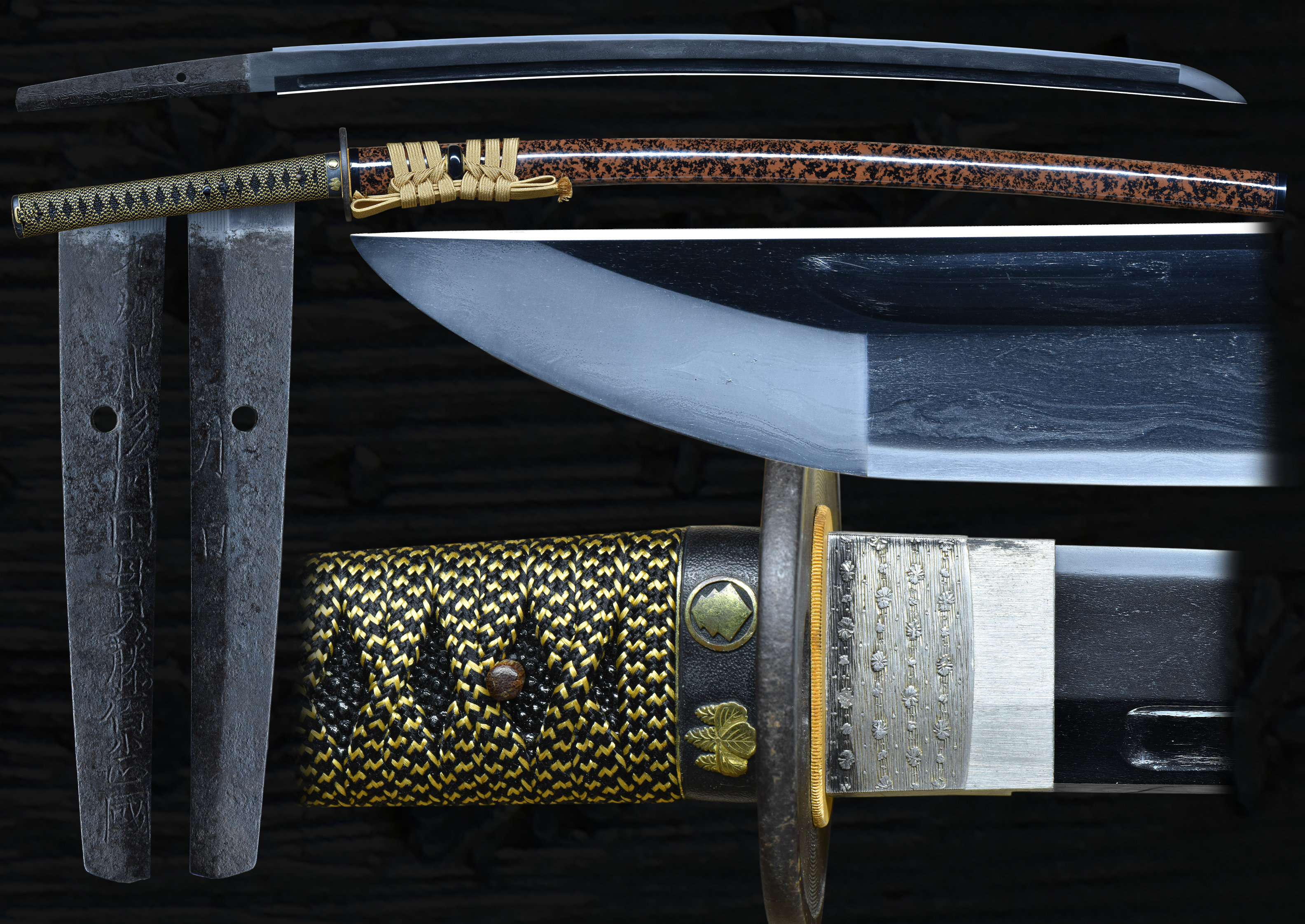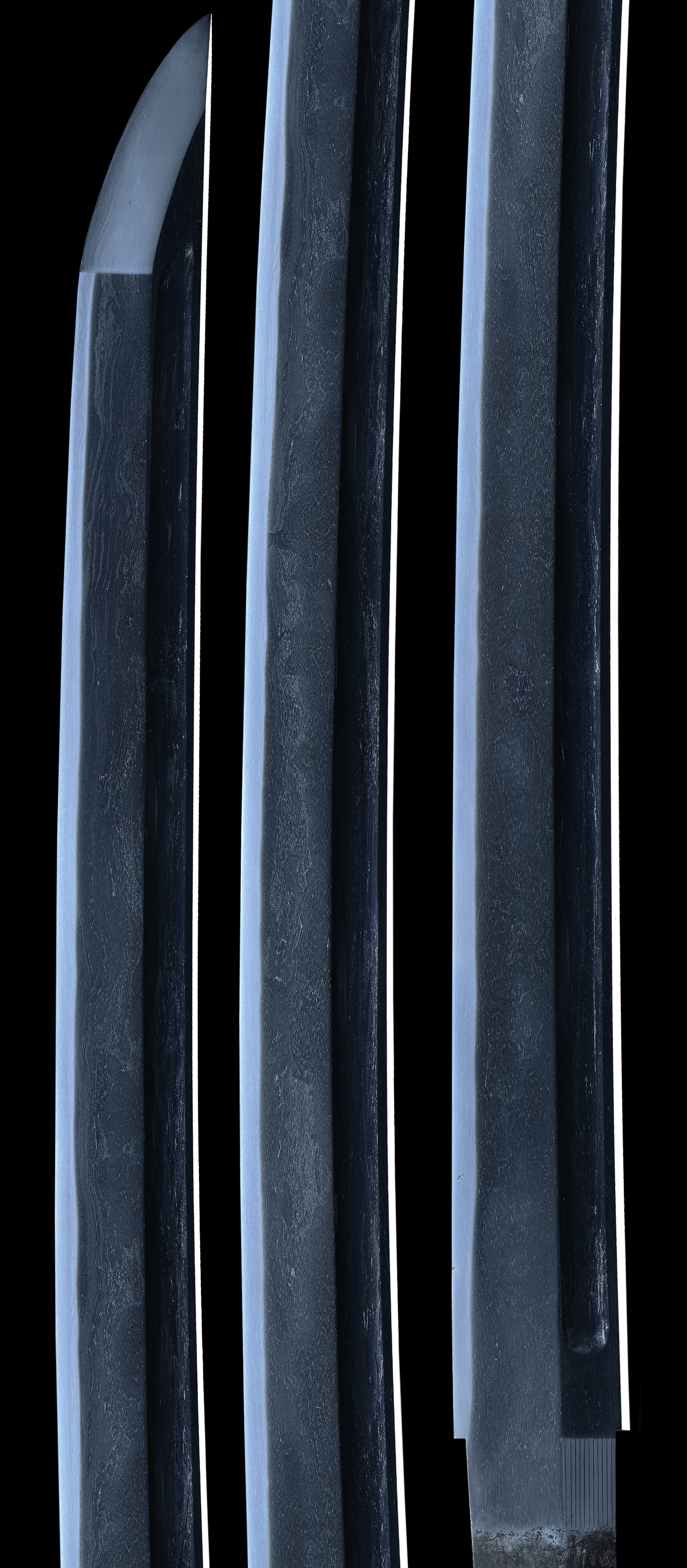This is a very good example of a longish Dotanuki sword signed with a long signature “KYÛSHÛ HIGO DOTANUKI FUJIWARA MASAKUNI and a “Gatsu Hi” on the other side meaning “Lucky month” the blade length is 27-1/2”. This sword has horimono in the form of Bohi. The blade’s hamon is a fine sugu-ha with small inner workings expertly controlled for a well cutting piece. Just above the habaki the blade has an honorable mark left from another sword when crossed. Its very small but historically interesting. The kissaki is longish bordering on being an O-kisaaki. The boshi is ko-maru with nijuba and kinsuji.The hada is as usual for these smiths is a combination hatatachi of masame nagare and itame nagare with some mokume, this hada has the feeling of a much older kamakura blade. There is shirake utsuri. The blade also seems to have fumbari left. This sword has a pronounced Tori-zori and are also known to be cherished for their cutting ability. There is chikei to be found.
The koshirae is a beauty of a set of mounts fully restored. The saya is lacquered in a Togidashi make stlye of a Black and Brown mottled design. The Sageo is a golden yellow in color. The Tsuka-ito is a golden yellow and black design that matches well with the sageo. The Same (rayskin) is black and there are menuki of running horses, The fuchi kashira are of samurai family mons.in a stone texture with waves. The seppa are gold washed. The Tsuba is iron with a circular pattern. A solid silver 2-piece habaki with a snowflake like pattern is seen. A beautiful old piece. This blade was papered with NTHK Kanteisho. The owner has misplaced them, we guarantee this sword to be correct and is an excellent example of Datanuki Masakuni.
- Mei: Ura side: KYÛSHÛ HIGO DOTANUKI FUJIWARA MASAKUNI-Omote side: Gatsu Hi
- Date: Tensho (1573)
- Nagasa: 27-1/2 inches
- Sori: 16.0 mm
- Width at the ha-machi: 34.2 mm
- Width at the yokote: 25.1 mm
- Thickness at the mune-machi: 8.8 mm
- Construction: Shinogi zukuri
- Mune: Iori
- Nakago: Ubu
- Kitae: Itame/mokume
- Hamon: Suguba
- Boshi: Maru
- Condition: Good polish
Click to Enlarge Image
Technical information about the Dotanuki School:
The Dotanuki school evolved in Higo Province with its ancestry going back to the famous “Enju Kunimura”. Enju Kunimura founded the Higo Enju school in approximately 1305. Kunimura was born in Yamato province to the swordsmith Hiromura. He moved to Yamashiro province and became a student of Rai Kuniyuki, and later married Kuniyuki’s daughter. Kunimura then moved to Higo and founded the Enju school. There are only six blades by Kunimura known to exist.Dotanuki School emerged in the small Higo village of Dotanuki in the mid-1500s, following the decline of the Higo Enju school in the latter part of the Koto period. The Dotanuki school founder is said to be Dotanuki Masakuni, he was called Oyama Kozuke no Suke and his original signature was Nobuyoshi. The famous general Kato Kiyomasa honored masakuni with one character of his name, and from that point onward Nobuyoshi was known as Masakuni. However, the majority of his works are only signed “Dotanuki Kozuke no Suke”, such as the sword presented here.Dotanuki swords quickly gained great popularity among the warrior class due to their superior cutting ability. The Dotanuki smiths cared little for aesthetics, but instead focused on strength, sharpness, and durability in the field. They were renowned for producing blades which would endure the harshest conditions, the most difficult battle field situations and survive to return to battle day after day, year after year.One of the most feared, respected and ruthless of Hideyoshi’s Generals was Kato Kiyomasa. General Kiyomasa was known as a ferocious and ruthless fighter, a true warrior. So intense was General Kiyomasa that he was called “Kishokan” or “Devil General”. When Hideyoshi sent General Kiyomasa to lead the invasion of Korea the General chose Dotanuki smiths to accompany him to ensure adequate swords could be produced in the field.Japan has become synonymous with high-end swords. For centuries, bladesmiths in Japan have produced some of the world’s finest swords and bladed weapons, ranging from the katana and wakizashi to the tanto and tachi. But there are different classifications of traditional Japanese swords, one of which is Dotanuki. So, what are Dotanuki swords exactly?
Dotanuki Swords Explained: Dotanuki swords are swords produced by a specific school of bladesmiths in the Higo province of Japan. Around the turn of the 14th century, a young bladesmith named Enju Kunimura traveled to the Higo province to start a new bladesmithing school. Kunimura grew up in the Yamato province. After learning the art of bladesmithing under the teachings of Rai Kuniyuki, however, he sought to start his own school, thus paving the way for the Dotanuki school of bladesmithing.Kunimura’s school wasn’t called “Dotanuki,” however. Rather, the Dotanuki school didn’t appear until several centuries later in the 16th century. Around the mid-16th century, the famous bladesmith Dotanuki Masakuni founded a new bladesmithing school in the Higo province using many of the same teachings as Kunimura. Over time, this school eventually received the namesake of Dotanuki, a reference to the founder’s name.
Characteristics of Dotanuki Swords: Martial arts practitioners and collectors both view Dotanuki swords as being some of the finest, highest-quality swords ever produced in Japan. There are a few reasons for this, one of which is their superior strength. Dotanuki swords could easily cut through most targets, allowing for superior performance that wasn’t found in other swords at the time (and even today for that matter).Swords produced in other provinces of Japan were often made with an emphasis on aesthetics. Bladesmiths would add intricate carvings and embellishments to make their swords more decorative. Dotanuki swords differed from these, however, in the sense that they were made with an emphasis on performance over aesthetics. They contained few decorative elements and were instead designed with performance features like a strong, sharp blade that was resilient to breakage.Dotanuki swords weren’t mass-produced like other swords, making them scarce and difficult for samurai warriors to acquire. But their superior strength and attention to detail allowed them to withstand the hands of time. Samurai warriors who used a Dotanuki sword in battle would typically find their sword unscathed. Other swords would break or sustain damage in battle, but the exceptional quality of Dotanuki swords allowed samurai warriors to use them time and time again.
Here is how Fujishiro has them rated:
MASAKUNI DOTANUKI [TENSHÔ 1573 HIGO] SUEKOTÔ CHÛSAKU
He was called Oyama Kozuke no Suke, his original signature was Nobuyoshi. He received one character from Katô Kiyomasa, and changed to Masakuni. The majority of his works are only inscribed with Dotanuki Kozuke no Suke. The swords he made have a wide body, a thick kasane, ji is ko‑moku tachi, hamon is sugu ko-midare nioi shimari. (Wazamono)
Signatures: KYÛSHÛ HIGO DOTANUKI KOZUKE SAKU
KIKUCHI JÛ DOTANUKI KOZUKE NO SUKE
KYÛSHÛ HIGO DOTANUKI FUJIWARA MASAKUNI
Plate I: KYÛSHÛ HIGO DOTANUKI FUJIWARA MASAKUNI
Previously, it was also said that Masakuni’s original name was Kunikatsu, but this is doubted. Also, it is said that Kozuke no Suke signed Kunihiro, but I have not seen these works. According to the research of Mr. Fukunaga Suiken, the lineage of the Oyama Uji of the son and grandson of Masakuni is “Oyama Kozuke no Suke Nobuyoshi later changed to Masakuni”, and from the works and such, Masakuni and Nobuyoshi were the same person, he was called Oyama Kozuke no Suke, and Kiyokuni is the same person as Kunikatsu and was called Oyama Samanosuke.
Plate II: KYÛSHÛ HIGO DOTANUKI KOZUKE NO SUKE
From the latter Kotô period until the beginning of the Shintô period, the changing of names was commonly done, and in the event (a smith) was taken into someone’s service, the employer (frequently the lord of a castle) would grant the use of one kanji of his name. This was also something that was seriously considered by the swordsmith, and the incentive for changing the name came about in this way.
(shipping and insurance included)
Email us if your interested in this item and remember to include the order number for this item: fss-886.
Click to Enlarge Image
Click to Enlarge Image
For Sale


























